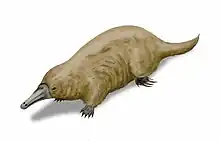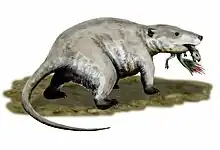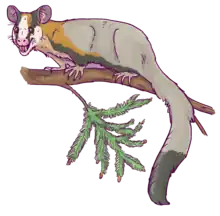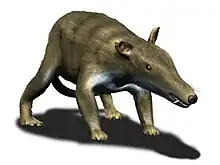| Condorodon | |
|---|---|
| Scientific classification | |
| Domain: | Eukaryota |
| Kingdom: | Animalia |
| Phylum: | Chordata |
| Class: | Mammalia |
| Clade: | †Eutriconodonta |
| Superfamily: | †Amphilestheria |
| Genus: | †Condorodon Gaetano & Rougier 2012 |
| Species | |
| |
Condorodon is a genus of extinct mammals from the Lower Jurassic Cañadón Asfalto Formation of the Cañadón Asfalto Basin in Patagonia, Argentina. The type species is C. spanios, described by Gaetano and Rougier in 2012.
Classification
One of the only two known South American eutriconodonts, Condorodon differs from the somewhat older Argentoconodon, a relative of Volaticotherium, in the morphology of the molariform teeth. It is closely related to the Late Jurassic amphilesthere Tendagurodon from the Tendaguru Formation of Tanzania, Africa.[2]
References
- ↑ Fantasia, A.; Föllmi, K. B.; Adatte, T.; Spangenberg, J. E.; Schoene, B.; Barker, R. T.; Scasso, R. A. (2021). "Late Toarcian continental palaeoenvironmental conditions: An example from the Canadon Asfalto Formation in southern Argentina". Gondwana Research. 89 (1): 47–65. Bibcode:2021GondR..89...47F. doi:10.1016/j.gr.2020.10.001. S2CID 225120452. Retrieved 27 August 2021.
- ↑ Gaetano, L. C.; Rougier, G. W. (2012). "First amphilestid from South America: a molariform from the Jurassic Cañadón Asfalto Formation, Patagonia, Argentina". Journal of Mammalian Evolution. 19 (4): 235–248. doi:10.1007/s10914-012-9194-1. hdl:11336/68489. S2CID 254698557. Retrieved 1 August 2022.
This article is issued from Wikipedia. The text is licensed under Creative Commons - Attribution - Sharealike. Additional terms may apply for the media files.




